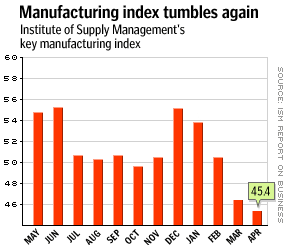NEW YORK (CNN/Money) - U.S. manufacturing activity shrank for a second straight month in April, the nation's purchasing managers said Thursday, as business activity was slow to rebound at the end of the U.S.-led war with Iraq.
The Institute for Supply Management said its index of manufacturing activity fell to 45.4 from 46.2 in March. Any number below 50 indicates contraction in the industry. Economists, on average, expected an ISM index of 47.3, according to a recent Reuters poll.
"Apprehension by supply managers about the impact of war appears to be diminished, as the war resulted in few, if any, consequences to supply chains," said Norbert Ore, chair of the ISM's survey committee. "They have now turned their concerns toward soft demand, as manufacturing lacks drivers at this time. Supply managers will look to consumer confidence and business confidence as major influencers for the second half of the year."

While consumer confidence has clearly rebounded in the wake of the war, business confidence has not. In poll after poll, CEOs have cited weak demand and expressed reluctance to undertake the sort of spending and hiring projects needed to help the economy grow with any gusto.
The report was not inconsistent with Federal Reserve Chairman Alan Greenspan's view that business confidence could be slow to recover, so it seems unlikely the ISM report will inspire the Fed to cut rates at its next policy meeting, scheduled for next Tuesday.
Though manufacturing represents less than 20 percent of the total economy, the ISM report is a decent indicator of overall post-war business sentiment, according to Merrill Lynch senior economist Gerald Cohen, particularly since many of the 400 businesses surveyed likely only submitted their survey responses at the end of the month, after the war was essentially over.
"It's consistent with the view that things are not good now, but there's the potential for a pickup," Cohen said. "The only question is what the magnitude of the pickup is going to be, and we're not as sanguine as [Greenspan is] about that."
The ISM's new orders index fell to 45.2 from 46.2 in March. The employment index fell to 41.4 from 42.1 percent in March, indicating the pace of layoffs in the manufacturing sector picked up in March.
| Related stories
|

|
|
|
|
Falling oil prices in the wake of the U.S.-led war with Iraq showed up in the prices paid index, which fell to 63.5 from 70.0 in March.
U.S. stock prices continued to fall after the report, while Treasury bond prices rose.
The U.S. manufacturing sector has been on the rocks for years. The ISM index first fell below 50 in August 2000 and stayed there until January 2002. About 2 million manufacturing jobs were cut during that time.
Manufacturing eked out some gains in 2002. But it suffered late in the year, along with other businesses, from fears about the possibility of war, leading to a Fed rate cut in November. Manufacturing recovered again in the winter, until the buildup to war brought it back down.
Most economists hope business activity will pick up again as the year goes on. Oil prices, which rose in the walk-up to war, acting as a sort of tax on businesses and consumers, have fallen. The "uncertainty" surrounding the war, cited so often by policy makers and businesses as a governor on growth, has lifted. Businesses have cut inventories and work forces to the bone, helping productivity and profits recover.
Still, the recovery, if one is indeed on the way, has stumbled out of the gate. New claims for unemployment benefits have stayed relentlessly and troublingly high, extending the most painful labor market slump since the end of World War II.
The Labor Department is scheduled Friday to release data on March unemployment and non-farm payrolls. Economists, on average, expect unemployment to creep up to 5.9 percent and for 53,000 jobs to be cut from payrolls, according to Reuters.
Early gauges of post-war manufacturing activity from New York, the mid-Atlantic region, and Chicago all have pointed to lingering factory weakness, setting the stage for Thursday's downbeat ISM report.

|

